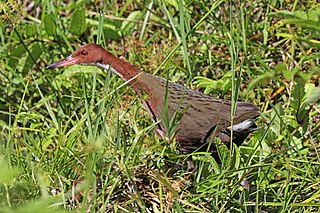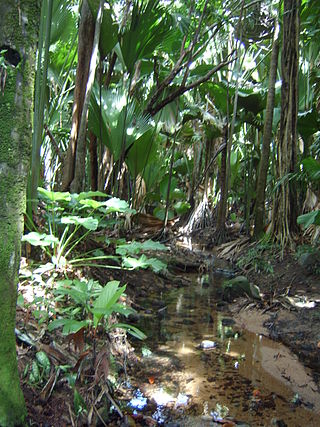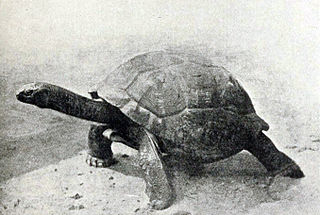
Tortoises are reptiles of the family Testudinidae of the order Testudines. Like other turtles, tortoises have a shell to protect from predation and other threats. The shell in tortoises is generally hard, and like other members of the suborder Cryptodira, they retract their necks and heads directly backward into the shell to protect them.

Aldabra is the world's second-largest coral atoll, lying southeast of the continent of Africa. It is part of the Aldabra Group of islands in the Indian Ocean that are part of the Outer Islands of the Seychelles, with a distance of 1,120 km (700 mi) southwest of the capital, Victoria on Mahé Island. Initially named by Arab seafarers for its harsh environment, Aldabra became a French colony dependency in the 18th century, leading to the exploitation of its natural resources, particularly giant tortoises. After passing through British hands, Aldabra faced potential military use in the 1960s, but international protests resulted in its protection. The atoll boasts unique geography, featuring the world's largest raised coral reef and a large shallow lagoon. Aldabra's history involves human impact, including failed agricultural ventures. Post-World War II, conservation efforts increased, leading to its inclusion in the British Indian Ocean Territory and eventual independence for Seychelles. Following an international protest by scientists known as the 'Aldabra Affair,' the Royal Society of London and later the Seychelles Islands Foundation conducted research, leading to Aldabra's declaration as a UNESCO World Heritage Site in 1982. The atoll's flora and fauna, notably the giant tortoises, comprise an 'ecological wonder', with Aldabra serving as a critical breeding ground for various species. Conservation challenges, such as invasive species and plastic pollution, persist, but protective measures, including UNESCO designation, underscore Aldabra's significance as a natural vital scientific research site. Aldabra receives limited tourism to safeguard its delicate ecosystem and is accessible primarily through guided tours.

Giant tortoises are any of several species of various large land tortoises, which include a number of extinct species, as well as two extant species with multiple subspecies formerly common on the islands of the western Indian Ocean and on the Galápagos Islands.

The Pinta Island tortoise, also known as the Pinta giant tortoise, Abingdon Island tortoise, or Abingdon Island giant tortoise, is a recently extinct subspecies of Galápagos tortoise native to Ecuador's Pinta Island.

The Aldabra giant tortoise is a species of tortoise in the family Testudinidae. The species is endemic to the Seychelles, with the nominate subspecies, A. g. gigantea native to Aldabra atoll. It is one of the largest tortoises in the world. Historically, giant tortoises were found on many of the western Indian Ocean islands, as well as Madagascar, and the fossil record indicates giant tortoises once occurred on every continent and many islands with the exception of Australia and Antarctica.
Adwaita, also spelled Addwaita, was a male Aldabra giant tortoise that lived in the Alipore Zoological Gardens of Kolkata, India. At the time of his death in 2006, Adwaita was believed to be amongst the longest-living animals in the world.

Aldabrachelys is genus of giant tortoises, including the Aldabra giant tortoise native to the Seychelles, as well as two extinct species, Aldabrachelys abrupta and Aldabrachelys grandidieri known from Madagascar.

The Galápagos tortoise or Galápagos giant tortoise is a very large species of tortoise in the genus Chelonoidis. The species comprises 15 subspecies. It is the largest living species of tortoise, with some modern Galápagos tortoises weighing up to 417 kg (919 lb). They are also the largest extant terrestrial ectotherms.

The white-throated rail or Cuvier's rail, is a species of bird in the family Rallidae.

The Reunion giant tortoise is an extinct species of giant tortoise in the family Testudinidae. It was endemic to Réunion Island in the Indian Ocean.

Cylindraspis is a genus of recently extinct giant tortoises. All of its species lived in the Mascarene Islands in the Indian Ocean and all are now extinct due to hunting and introduction of non-native predators.

The saddle-backed Rodrigues giant tortoise is an extinct species of giant tortoise in the family Testudinidae. The species was endemic to Rodrigues. Human exploitation caused the extinction of this species around 1800.

The Granitic Seychelles are the islands in Seychelles which lie in central position on the Seychelles Bank and are composed of granite rock. They make up the majority of the Inner Islands, which in addition include the coral islands along of the rim of the Seychelles Bank, namely Bird Island and Denis Island. The Granitic Seychelles contrast with the Coralline Seychelles or the Outer Islands, several island groups made up of low coral islands with dry, infertile soils.

The wildlife of Seychelles comprises the flora and fauna of the Seychelles islands off the eastern coast of Africa in the western Indian Ocean.

Jonathan is a Seychelles giant tortoise, a subspecies of the Aldabra giant tortoise. His approximate age is estimated to be 191 as of 2024, making him the oldest known living land animal. Jonathan resides on the island of Saint Helena, a British Overseas Territory in the South Atlantic Ocean.

Aldabrachelys grandidieri, or Grandidier's giant tortoise, is an extinct species of tortoise that was endemic to Madagascar. Mitochondrial DNA extracted from subfossil bone confirm that it is a distinct species.

The Seychelles giant tortoise, also known as the Seychelles domed giant tortoise, is a tortoise subspecies in the genus Aldabrachelys.
Giant tortoises are any of various large land tortoises

Chelonoidis niger chathamensis, commonly known as the Chatham Island giant tortoise or the San Cristóbal giant tortoise, is a subspecies of Galápagos tortoise endemic to San Cristóbal Island in the Galápagos.

Solitudo is an extinct genus of tortoise that was found during the Pliocene and Pleistocene on the Mediterranean islands of Menorca, Malta and Sicily. The genus includes three described species, Solitudo robusta, Solitudo gymnesica and Solitudo sicula as well as a likely fourth, undescribed species from Monte Pellegrino in Sicily. Solitudo sicula, the youngest of the species, died out approximately 12.5 thousand years BP. The largest species, Solitudo gymnesica, has been estimated to have reached a carapace length of 1.1–1.3 m (3.6–4.3 ft).


















